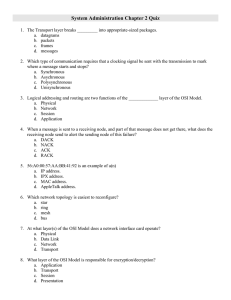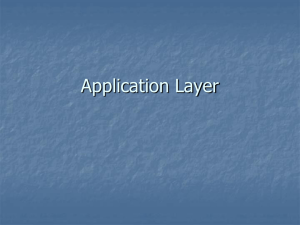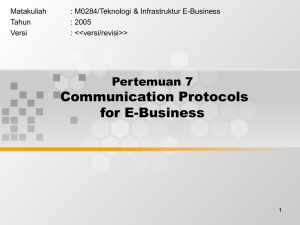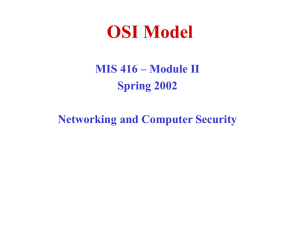The OSI reference model Data Communications 1 What is Open Systems Interconnection? lecturer:
advertisement
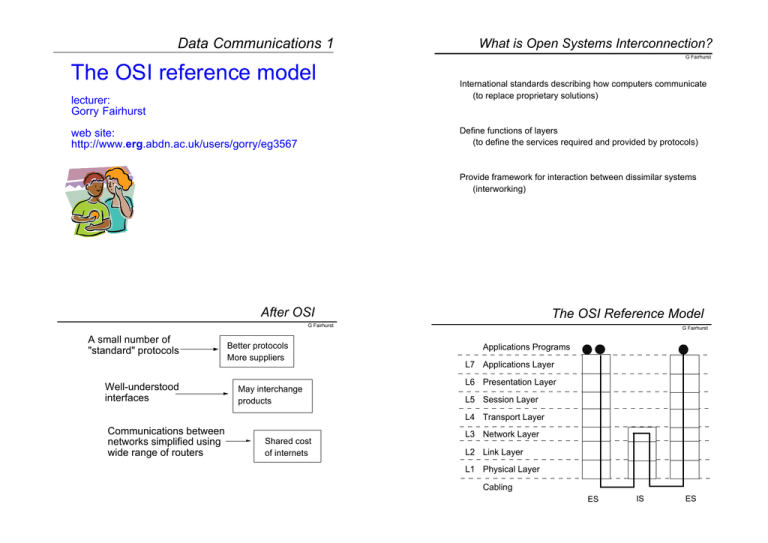
Data Communications 1 What is Open Systems Interconnection? G Fairhurst The OSI reference model lecturer: Gorry Fairhurst International standards describing how computers communicate (to replace proprietary solutions) Define functions of layers (to define the services required and provided by protocols) web site: http://www.erg.abdn.ac.uk/users/gorry/eg3567 Provide framework for interaction between dissimilar systems (interworking) After OSI The OSI Reference Model G Fairhurst A small number of "standard" protocols (IP, CLNP, X.25, etc) Well-understood interfaces Better protocols More suppliers May interchange products G Fairhurst Applications Programs L7 Applications Layer L6 Presentation Layer L5 Session Layer L4 Transport Layer Communications between networks simplified using wide range of routers Shared cost of internets L3 Network Layer L2 Link Layer L1 Physical Layer Cabling ES IS ES Network Functions v End User Functions Subnetwork OSI Layers 1-3 G Fairhurst End System B End System A Application Layer Middleware Presentation Layer Rôle 3Network Layer Network routing, call establishment and clearing, addressing, individual call management. Presentation Layer End User Function Session Layer Transport Layer Transport Layer Network Layer Network Layer Data Link Layer Layer Application Layer Session Layer Network Services G Fairhurst Network Functions Data Link Layer Physical Layer 2(Data) Link Layer Data framing, data transparency, error control, management, link establishment and clearing. 1Physical Layer Physical Layer Physical Medium Network Service Mechanical interface, electrical interface, signalling and interface control. End System Software OSI Layers 4-7 G Fairhurst End User A End User B Application Layer Application Layer Higher Layers Presentation Layer Presentation Layer Session Layer Session Layer Transport Layer Transport Layer "Pipe" G Fairhurst Layer Rôle 7Application Layer Application services: Reliability, library functions. 6Presentation Layer Data-oriented communication tasks: Transfer syntax , data transformation. 5Session Layer Application-oriented communication : Dialogue and synchronisation control. 4Transport Layer End-to-end communication: Connection management, segmentation, resequencing, error control, flow control. "Pipe" Network Network Services End System Software Protocol Layer OSI Layers 4-7 G Fairhurst G Fairhurst Layer Rôle 7Application Layer Application services: Reliability, library functions. N-Service Access Point N- Protocol Layer 6Presentation Layer Data-oriented communication tasks: Transfer syntax , data transformation. 5Session Layer Application-oriented communication : Dialogue and synchronisation control. Protocol Entity N-1 Service Access Point 4Transport Layer End-to-end communication: Connection management, segmentation, resequencing, error control, flow control. Each entity (instance of a protocol) sends and receives data via the Service Access Points SAPs using service primitives OSI Layer Services OSI Layer Services G Fairhurst G Fairhurst OSI introduced the notion of a “protocol layer” providing a “service” Layer A layer providesUser a service to theService layers above. Each User B provided N+1 request data)confirm indication is providing using the response layer below The service (moving Layer N Protocol entity Service used Peer protocol entity Layer N-1 Layer N+1 Layer N User A request confirm Protocol entity Service provided Service used User B response indication Peer protocol entity Layer N-1 Protocol Data Units (PDUs) The packets / frames sent by a layer are called “PDU”s Protocol Data Units (PDUs) PDU Encapsulation PDU Encapsulation / OSI RM G Fairhurst G Fairhurst N+1 Protocol Layer 7 PDU Protocol Control Information 6 7 5 6 7 N- Protocol Layer 4 5 6 7 PCI + PCI Layer N+1 Protocol Data Unit becomes a Layer N Service Data Unit SDU SDU 3 4 5 6 7 Layer N PDU 2 3 4 5 6 7 1 2 3 4 5 6 7 1 3 5 6 7 N-1 Protocol Layer PCI + SDU Service Primitives Service Primitives G Fairhurst Client (ES) G Fairhurst N+1-Data-Request Server (ES) N+1-Data-Indication Request Indication Response N-Layer Confirm N-Layer Request Indication (Unconfirmed Service) Segmentation / Fragmentation OSI Interfaces G Fairhurst G Fairhurst From Layer N+1 System A N- Protocol Layer System B Peer Protocol Layer (N+1) Layer (N+1) Service Interface Service Interface SDU Header SAP PCI + SDU PCI + SDU SAP PCI SDU Layer (N) Layer (N) Peer Protocol Two calls to N-1 Protocol Layer OSI Tutorial Question The rôle of OSI G Fairhurst Advantages of OSI: Equipment X Vendor independent communication Fewer "standard" protocols Client Server Standard transportation networks 1) Assume the equipment X is a 100 Mbps Ethernet hub. Problems with OSI: ISO defined its own OSI protocol stack Throughput lower than with application-oriented protocols A reference framework for describing protocols (a) Using the OSI reference model, sketch the protocol stack (b) Sketch the Ethernet MAC frame header received by the server 2) Repeat above for equipment X being an Ethernet switch. 3) Repeat above for equipment X being a network layer router.

